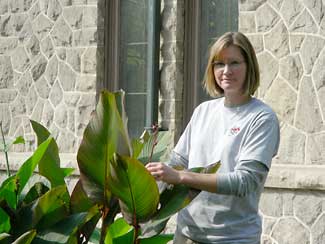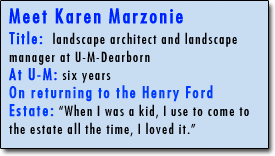Karen Marzonie knows all too well that in life timing is everything.

“Usually at this time of year we’re planting tulip bulbs, but instead we’re taking advantage of the extra time to do more landscaping,” she says, referring to the unusually hot October weather.
Much like Michigan’s weather, you can’t always predict what’s going to happen.
Marzonie, a landscape architect and landscape manager at U-M-Dearborn, works as the garden manager at the Henry Ford Estate in Dearborn. She’s worked there for six years, but in reality, she’s been there much longer. “When I was a kid, I use to come to the estate all the time, I loved it,” says Marzonie, a Dearborn native.
A graduate of Edsel Ford High School and the U-M School of Natural Resources and Environment, Marzonie returned to the estate in 1987 as an intern during her grad school years.
After graduating, a landscape architecture job kept her in Ann Arbor, where she spent the next 14 years.

In 2001 all of that changed. The nieces of the Ford family funded a part-time position for a landscape architect and hired Marzonie. “My husband and I were about to adopt a child and move to Dearborn, so the timing of the job was great,” she recalls.
In her six-year tenure, Marzonie continued to develop the landscaping program. She currently works with 30 volunteers, but the hours vary. “Some people work five hours a year, others work well over 100,” she says.
Pamla Morrison, the estate’s garden volunteer coordinator and horticulturist, works with the volunteers on Mondays and Fridays from March through October.
There are several other groups that contribute as well. The Ford Community Service Program, Boy Scouts of America and U-M-Dearborn students all donate time to rebuilding and repairing structures and walkways, along with other projects the estate may have.
Marzonie’s job also involves a lot of community outreach.
“The majority of our funding to preserve the estate comes from donations, grants and fund raising,” she says. “In the spring we have a plant sale and we sometimes do a yard sale later in the summer. One of my favorite programs takes place on Oct. 29 when volunteers dress in Halloween costumes, decorate 10 areas in the garden and pass out trick-or-treats to local children. These smaller programs help us generate money but are also a lot of fun.”
Outside of the day-to-day work, Marzonie really appreciates Mother Nature’s surroundings. “We have all types of plant life and animals here. Native honeylocust trees with thorns are rare to the area but are found on the grounds,” she says.
One of the estate’s treasured natural wonders is the 300-year-old bur oak. “This tree was here long before the Ford’s bought the property, back when it was farm land. You can see where lightening has struck it several times, and yet, every year it still buds and produces leaves,” Marzonie says.
For an urban area, the grounds host an array of animals as well. The red fox, white-tailed deer and coyote are just some of the animals visitors may encounter while touring the estate.
So what makes the estate such a great place to work and visit? “Two things,” says Marzonie. “The donors and volunteers cannot be thanked enough; without them we wouldn’t be able to do the things we do. Also the staff members are great; they work hard but also are a lot of fun. We have a great time.”
To learn more about the Henry Ford Estate, go to www.henryfordestate.org.

